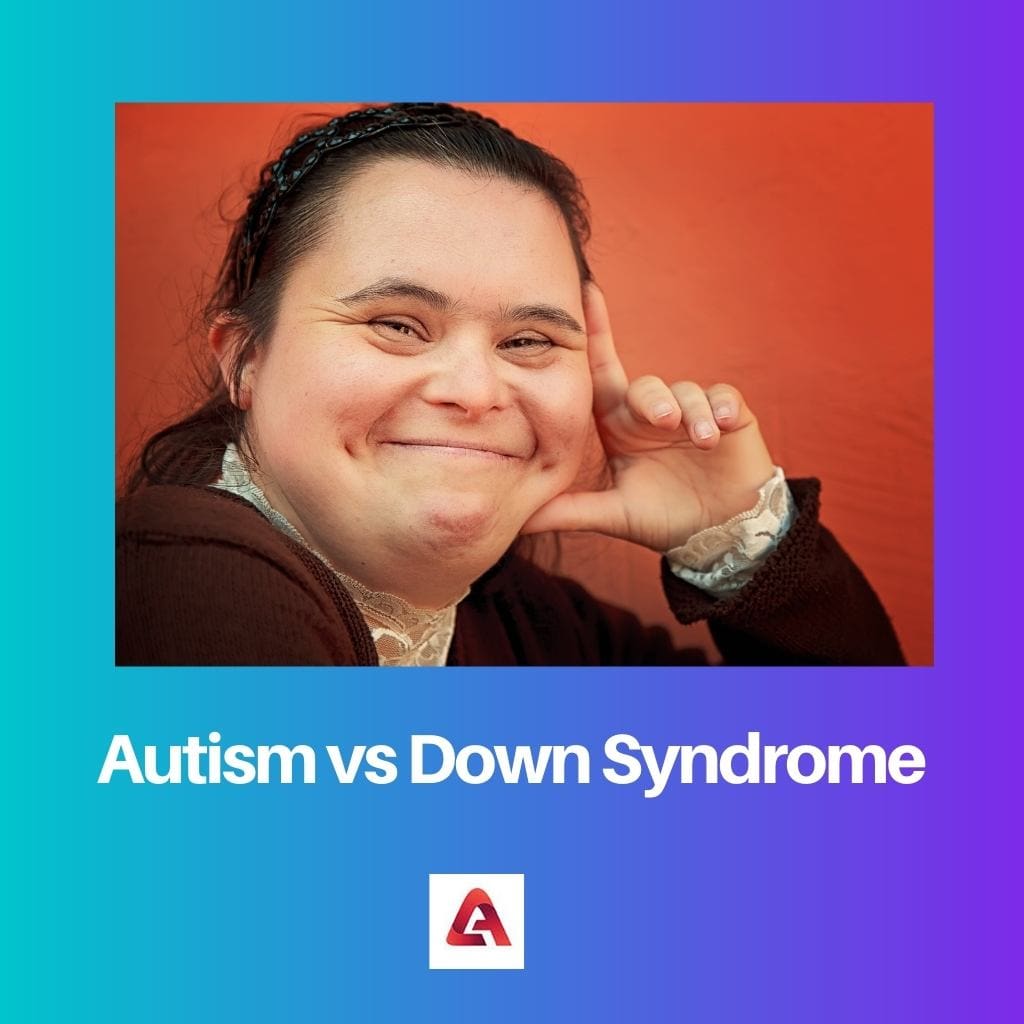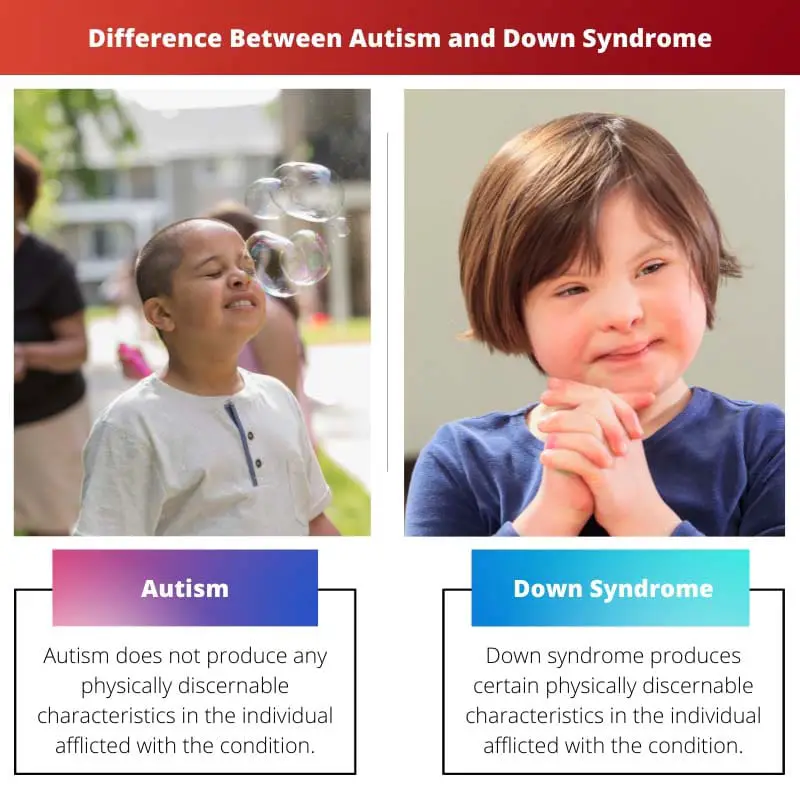Down syndrome is a genetic condition caused by a gene mutation in the 23rd chromosome that causes the development of certain distinct facial features in the afflicted individual.
These changes may include a smaller-sized head, flat facial features, shorter necks, etc.
However, autism is a neurological condition that does not produce any distinctive change in the facial features of the individual living with the condition.
It produces certain cognitive changes but not easily identifiable changes in the individual’s appearance.
Key Takeaways
- Autism is a neurodevelopmental disorder that affects communication, social interaction, and behavior, while Down Syndrome is a genetic disorder caused by an extra copy of chromosome 21.
- Autism is diagnosed during early childhood, while Down Syndrome can be detected during pregnancy or after birth through genetic testing.
- Autism is treated through behavioral therapy, medication, and educational support, while Down Syndrome requires ongoing medical care, early intervention, and education.
Autism vs Down Syndrome
Autism is a neurodevelopmental disorder that affects social interaction, communication, and behaviour. Down syndrome is a genetic disorder that is caused by the presence of an extra chromosome 21. It is depicted by intellectual disability, distinctive facial features, and other physical traits.

Comparison Table
| Parameters of Comparison | Autism | Down Syndrome |
|---|---|---|
| Physically Discernable Characteristic | Autism does not produce any physically discernable characteristics in the afflicted individual. | Down syndrome produces certain physically discernable characteristics in the afflicted individual. |
| Diagnostic Window | Autism can be diagnosed at a fairly young age. | Down syndrome can be diagnosed when the fetus is still inside the womb. |
| Type of Condition | Autism is a neurological condition. | Down syndrome is a genetic condition. |
| Causes | The causes of autism are unknown. However, hereditary factors are included among the probable causes. | An extra copy of the 21st chromosome causes the down syndrome. |
| Impairment Caused | Social cognition and communication impairments. | Delayed growth, learning disabilities, and several other physical disabilities. |
| Spectrum Condition | Autism is a spectrum condition. It is also commonly known as ASD or Autism Spectrum Disorder. | Down syndrome is not a spectrum condition. |
What is Autism?
Autism is a spectrum condition that causes development impairments among those living with it.
It is a neurological disorder that affects the nervous system of individuals such that their cognitive and communicative abilities are severely affected.
The capability of the individual to interact with others is severely compromised.
As such, the leading causes of the disorder are largely unknown to the medical community. However, hereditary factors are considered among the most significantly suspected risk factors.
According to a study conducted by the CDC, boys are more prone to autism than girls.
The symptoms of autism become apparent during the early childhood years of a baby. The crucial window between 12-24 months is when most symptoms become ostensible.
These symptoms may include problems with social interactions, processing social cues, repetitive patterns of behaviour, etc. Developmental screenings and other tests have been instituted to confirm an autism diagnosis.
As a spectrum condition, autism includes autistic disorder, Asperger’s syndrome, PDD-NOS, and childhood disintegrative disorder. There are no cures for the condition.
It can be managed with behavioural, speech, and physical therapy.

What is Down Syndrome?
Down syndrome is a genetic disorder where the child is born with an extra copy of the 21st chromosome. This condition causes serious physical and mental developmental delays in the individual born with it.
Down syndrome can be further subcategorized into three groups. Trisomy 21 is the most common form of Down syndrome in statistics.
Under this category, the extra copy of the gene is present in each cell of the individual. Mosaicism occurs when the child has an extra copy in some but not all cells.
And the last variant is translocation, where the child has only an extra part of the 21st chromosome, not the entire extra copy.
Down syndrome produces certain discernable physical features in the child, including smaller heads and ears, flat features, shorter necks, and others.
Cognitive disabilities include learning issues, impulsive behaviour, shorter attention span, etc. Individuals with the condition are predisposed to certain physical ailments like poor vision, congenital heart defects, leukaemia, etc.
Prenatal tests like amniocentesis, CVS, and others help screen for the markers of this genetic condition during the gestation period. Similarly, after the child’s birth, a karyotype test is performed to confirm the diagnosis.

Main Differences Between Autism and Down Syndrome
- The main difference between autism and Down syndrome is that the former is a neurological condition, while the latter is a genetic condition. The former condition produces no discernable change in the individual’s physical features. However, the genetic mutation in the latter condition produces certain characteristic physical features in the individuals living with the condition.
- The diagnostic timelines of each condition vary. While autism can be diagnosed in the early months of infancy, Down syndrome can be detected when the fetus is still inside the womb.
- Autism causes severe developmental impairment in the individual such that the person’s ability to communicate is gravely impacted. Conversely, Down syndrome is a genetic condition resulting from the presence of a 3rd copy of the 21st chromosome.
- The causes of each condition are quite different. While the causes of autism are mainly unknown, Down syndrome is caused due to the occurrence of an extra copy of the 21st chromosome in the fetus.
- Autistic individuals perceive the world differently. Impairment of social cognition, communication, sensory sensitivity, etc., are common repercussions of the condition. Alternatively, Down syndrome causes growth delays in the individual. It also leads to the development of smaller facial features and learning disabilities.
- Autism is a spectrum condition. This connotes that being autistic affects different individuals differently. Asperger’s Syndrome is another condition that falls within the autistic range. However, Down syndrome is not a spectrum condition.




